Research Update
Today our research team collected sediment samples at Cape Evans near two helicopter landing sites. Tomorrow afternoon our team will hopefully go to Cape Royds to sample sediments. Also, today is my birthday. My research team made sure everyone knew by having me parade around Crary Lab dressed up as a penguin wearing a birthday sash. I was up for the task!
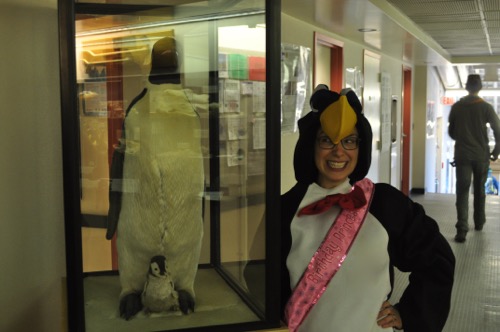 Michelle Brown poses as a penguin in Crary Lab on her birthday.
Michelle Brown poses as a penguin in Crary Lab on her birthday.
Cape Evans
Our team drove snowmobiles out to Cape Evans, which sits on the coast of Ross Island, 22 kilometers north of Hut Point Peninsula. It was a sunny, clear day and we had a great view of Mt. Erebus, an active volcano, on our drive.
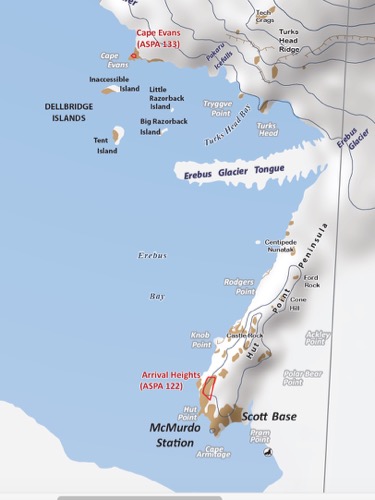 An insert of a map of Ross Island shows McMurdo Station and Cape Evans. Courtesy of Antarctic Geospatial Information Center.
An insert of a map of Ross Island shows McMurdo Station and Cape Evans. Courtesy of Antarctic Geospatial Information Center.
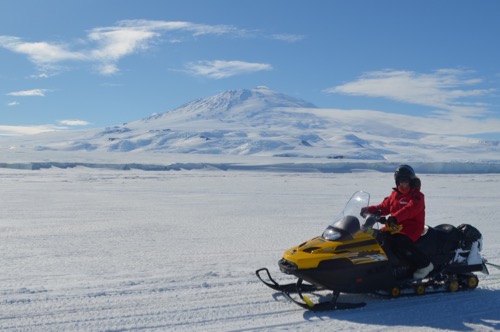 Michelle Brown rides on a snowmobile to Cape Evans with Mt. Erebus in the background.
Michelle Brown rides on a snowmobile to Cape Evans with Mt. Erebus in the background.
Sampling Time
It was very windy when we first arrived at Cape Evans. Despite the tough elements, our team was efficient at gathering sediment samples. We collected samples at two helicopter landing sites before visiting the historic hut.
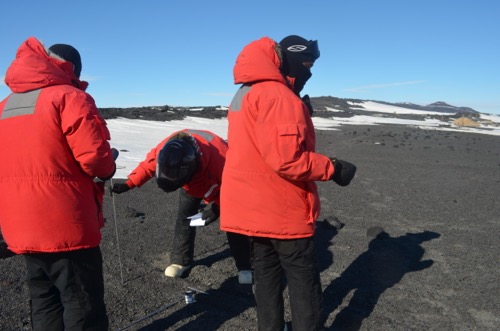 Andrew Klein, Terry Palmer and Carl Green collect sediment samples at a site near Scott's historic hut.
Andrew Klein, Terry Palmer and Carl Green collect sediment samples at a site near Scott's historic hut.
A Historic Hut
After we sampled sediments, we took time to visit Robert Falcon Scott's Terra Nova Hut, which is the largest hut in the Ross Sea region. It was built in January of 1911 by Scott and his team during their Terra Nova expedition from 1910-1913. The hut has inner and outer walls and is insulated by quilts with seaweed sewn into them.
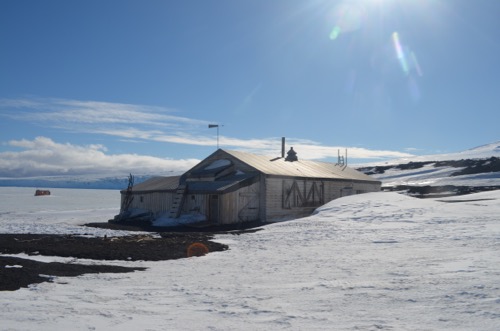 Robert Falcon Scott's hut at Cape Evans
Robert Falcon Scott's hut at Cape Evans
This was Scott's second expedition--he returned to Antarctica after a failed attempt to reach the South Pole in a 1901-1904 expedition. This second expedition wasn't only about reaching the South Pole. In March of 1911, members of the expedition went to the Dry Valleys and Taylor Glacier to survey the area. From November, 1911 to February, 1912 a team surveyed Granite Harbour and Mackay Glacier, where they conducted geology work and identified glacier features. In the winter, men collected Emperor Penguin eggs to better understand evolution and embryology. The team also had plans to study the magnetism and meteorology of the area.
 Robert Falcon Scott sits at a desk inside his hut at Cape Evans around 1911. Photo courtesy of wikimedia.org
Robert Falcon Scott sits at a desk inside his hut at Cape Evans around 1911. Photo courtesy of wikimedia.org
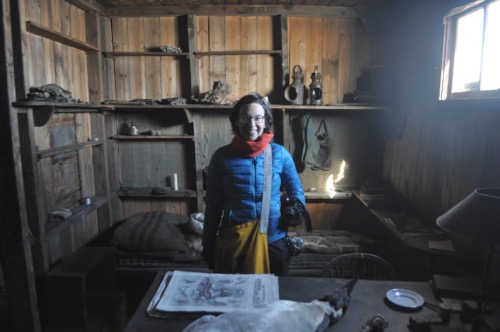 Michelle Brown stands behind the same desk that was photographed in 1911, over a century later.
Michelle Brown stands behind the same desk that was photographed in 1911, over a century later.
During the Terra Nova expedition, Scott and four other men, who were British, tried to beat the Norwegian team led by Roald Amundsen to the South Pole, a destination over 800 miles away. Sadly, he reached the landmark a month after Amundsen had been there. The team, discouraged and defeated, trekked back towards Cape Evans. Along the way members suffered frostbite. While crossing the Beardmore Glacier in February, team member Edgar Evans suffered from frostbite and head injuries and eventually collapsed and died. Meanwhile, scientist Scott Wilson found 30 pounds of fossils to add to their sled load, which later helped prove the theory of Continental Drift. As the party continued, temperatures dropped, fuel supplies were low and another member, Lawrence Oates, continued to suffer from frostbite. To make matters worse, dog teams which were meant to take them the rest of the way back did not arrive at a meet up point. Oates left the tent one day saying "I am just going outside and may be some time", never to return. Three men, including Scott, Wilson and Henry Bowers remained and struggled onward. In March a fierce blizzard stymied their progress. With only 11 miles to food and safety and 150 miles to Cape Evans, the three men died in their tent.
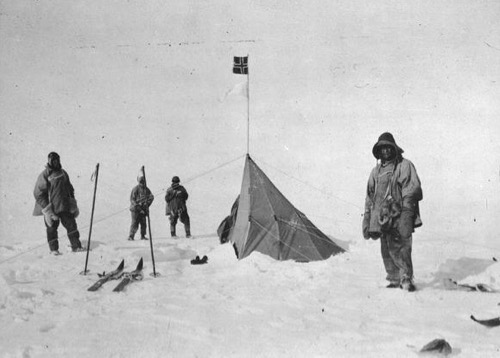 Robert Scott and his men in front of Amundsen's tent at the South Pole. Photo courtesy of wikimedia.org
Robert Scott and his men in front of Amundsen's tent at the South Pole. Photo courtesy of wikimedia.org
Frozen in Time
Stepping into the hut at Cape Evans is like stepping back in time. Objects from the past sit on the shelves, frozen (literally) in place. In 1911, 25 men from Scott's Terra Nova expedition lived in the hut and stayed until 1913. From 1915 - 1917, 10 men from a later expedition led by Ernest Shackleton used the hut when they couldn't get on their boat. The hut was locked up by Shackleton in 1917 and was untouched for decades. Thanks to the New Zealand's Antarctic Heritage Trust, it is largely in tact and can be visited today if you go with a guide. Luckily I am trained to be a guide!
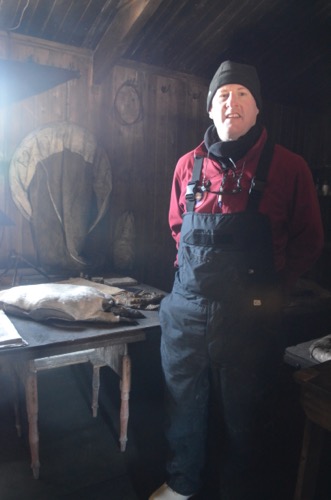 Andrew Klein stands near an Emperor Penguin inside the hut at Cape Evans.
Andrew Klein stands near an Emperor Penguin inside the hut at Cape Evans.
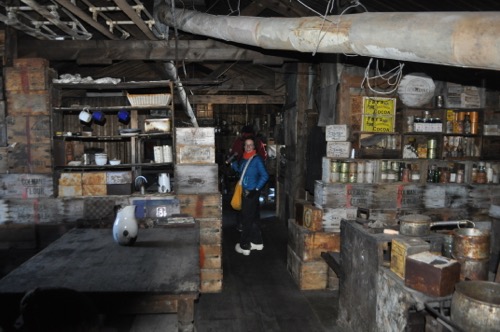 Michelle Brown walks past the kitchen in the large hut at Cape Evans.
Michelle Brown walks past the kitchen in the large hut at Cape Evans.
 Scientific equipment remains on a table inside the hut.
Scientific equipment remains on a table inside the hut.
Penguin Time
Once we returned to McMurdo Station, I spent some time with Jean Pennycook. Jean is a former science teacher who now studies Adelie penguins at a penguin rookery in Cape Royds. When she is not studying the behavior of penguins, she is sending back penguin postcards from Antarctica and finding other ways to connect students to penguin science. I recommend teachers and students look at her wonderful resources! I spent some time helping her stamp postcards that will go back to students across the U.S.
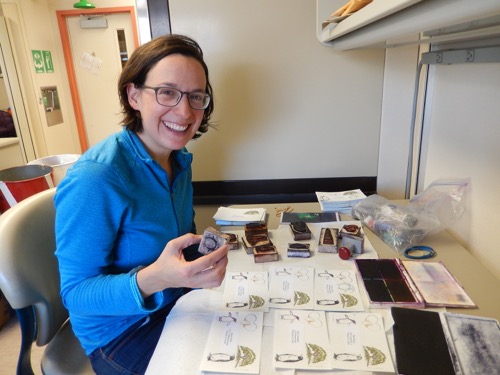 Michelle Brown stamps penguin postcards that Jean Pennycook will mail to children back in the U.S.
Michelle Brown stamps penguin postcards that Jean Pennycook will mail to children back in the U.S.
Life in Antarctica
The McMurdo Store is a great place to buy souvenirs, snacks and toiletries. This evening it was open and in full swing!
 The McMurdo Store is right by the galley in the main building at McMurdo Station.
The McMurdo Store is right by the galley in the main building at McMurdo Station.
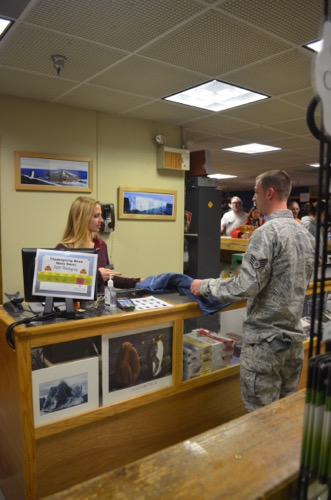 A patron purchases a souvenir from the McMurdo Store.
A patron purchases a souvenir from the McMurdo Store.
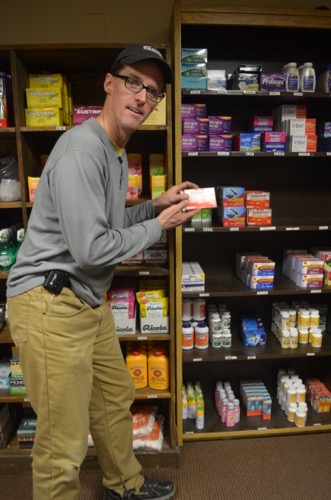 Steve Zellerhoff shops for cold medicine from the McMurdo Store.
Steve Zellerhoff shops for cold medicine from the McMurdo Store.
Ice Picture of the Day
Today's picture of the day connects to Scott's Terra Nova expedition. Scott Wilson's discovery of fossils may have weighed down Scott's sled, but it also helped make great scientific advances. To learn more and download a PowerPoint slide, click here 17_icepod.pptx
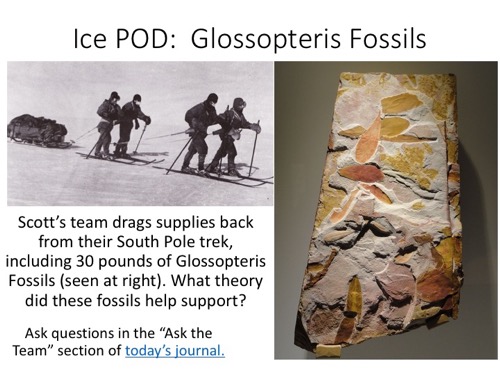 Ice Picture of the Day, day 17
Ice Picture of the Day, day 17
Brought to you by...
Today's journal is brought to you by Mrs. Vasey's class from Hans Herr Elementary School in Lampeter, Pennsylvania.
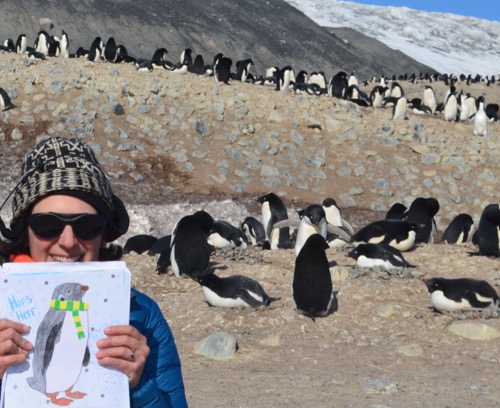 Today's journal was brought to you by Mrs. Vasey's class from Hans Herr Elementary School in Lampeter, Pennsylvania.
Today's journal was brought to you by Mrs. Vasey's class from Hans Herr Elementary School in Lampeter, Pennsylvania.
Comments